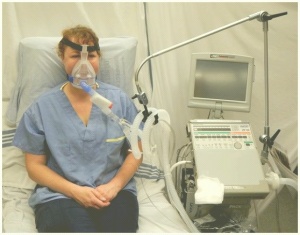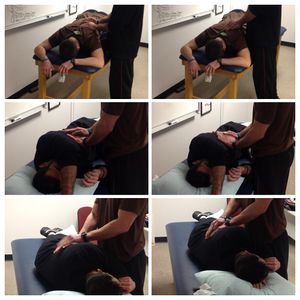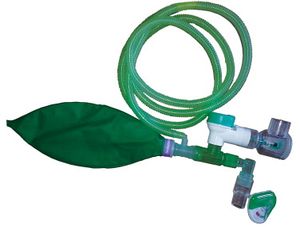Respiratory failure is a condition in which the respiratory system fails in one or both of its gas-exchanging functions; that is, oxygenation of, and carbon dioxide elimination {from, mixed venous (pulmonary arterial) blood.
++++++++++++++++++
Hypoxemic respiratory failure is defined by arterial O2saturation <90% while receiving an increased inspired O2 fraction. Acute hypoxemic respiratory failure can result from pneumonia, pulmonary edema (cardiogenic or noncardiogenic), and alveolar hemorrhage. Hypoxemia results from ventilation-perfusion mismatch and intrapulmonary shunting.
Present when arterial O2 saturation (Sao2) <90% occurs despite an increased inspired O2 fraction
Results from ventilation-perfusion mismatch or shunt present in:
acute respiratory distress syndrome, heart failure with pulmonary edema, pneumonia, sepsis, complications of surgery and trauma), which accounts for ~65% of all ventilated cases, and
This type occurs with alveolar flooding and subsequent intrapulmonary shunt physiology.
Alveolar flooding may be a consequence of pulmonary edema, pneumonia, or alveolar hemorrhage.
It occurs in clinical settings such as sepsis, gastric aspiration, pneumonia, near-drowning, multiple blood transfusions, and pancreatitis.
++++++++++++
ARF is defined as a sudden (minutes to hours) inability of the lungs to maintain normal respiratory function, resulting in abnormal arterial oxygen or carbon dioxide levels.
Whether classified as Type 1 (hypoxemic) or Type 2 (hypercarbic), ARF represents a major immediate threat to homeostasis and is a medical emergency.
Patients with Type 1 ARF have hypoxemia as their predominant blood gas abnormality. Typically, these patients are anxious and intensely focused on relieving their dyspnea. When you attempt to obtain their history, they may not be able to cooperate, repeating phrases like “I can't breathe” or “Help me.” You may note use of accessory muscles of respiration and, in severe cases, cyanosis. The patient may exhibit unstable vital signs as well. Your differential should include parenchymal and interstitial disease (pneumonia, aspiration, COPD or CHF exacerbation, ARDS) as well as diseases that can cause an acute right-to-left shunt (pulmonary embolism).
Patients with Type 2 ARF have high pCO2 levels as their predominant blood gas problem. They may be hypoxemic as well. These patients can exhibit a “narcosis,” appearing confused, intoxicated, or unresponsive. On physical examination, you may find a tremor or asterixis, peripheral vasodilation with pink nail beds, and significant bradycardia or sinus pauses. Your differential should include disease states that can induce a shallow or inadequate respiratory effort such as asthma or COPD exacerbation in a patient who has “tired out,” neuromuscular issues such as Guillain-Barré syndrome, oversedation with narcotic medications, strokes or brain stem lesions, and structural issues such as severe kyphoscoliosis. In the hospital setting, a few of these issues can combine to turn a chronic condition into an acute problem. For instance, a patient with morbid obesity and resultant sleep apnea who is then hospitalized for a knee replacement and given narcotics for pain control could develop significant hypercarbia due to an acute worsening of the sleep apnea from the sedating effects of the analgesics.
Mechanical Ventialtion
ABGs are essential for the correct diagnosis and treatment of ARF, and doctors should not hesitate to order them when appropriate.
Do not hesitate to intubate and mechanically ventilate a patient with ARF who is not appropriate for or not responding to noninvasive ventilation. A calm, organized intubation is much safer and results in better clinical outcomes than an emergent intubation done after a patient has become unstable or suffered a cardiopulmonary arrest.
Many patients have undiagnosed chronic hypoxia with few clinical signs or symptoms. When hospitalized, the addition of supplemental oxygen, sedating medications, or the stress of an acute illness can cause hypercarbic ARF, which often manifests clinically as altered mental status or delirium.


